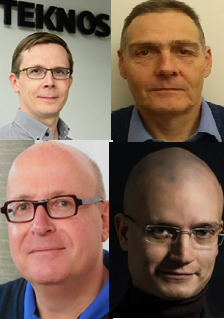
Pasi Virtanenen, Teknos
In the wood and timber sectors, Teknos’ industrial customers today are looking for ‘green’ coating and treatment solutions: water based, VOC emissions free, non-halogenated and if possible bio-based. In the construction sector, demand for fire safety treatments is increasing, especially for public buildings, with today also demand for low smoke (Euroclass). Customers want flame retardants to be non-halogenated, and to not be subject to Hazard labels. “Nano” materials are also beginning to raise questions in some markets. Challenges include ensuring stability of raw materials (in order to reliably achieve precise customer product specifications), the need to ensure repeatable results in fire testing, the complexity of fire testing (several different tests for the same product for different applications) leading to large product portfolio and the development of more “efficient” fire safety treatments. That is, products which achieve fire safety with lower loadings, for example by using targeted synergists. Teknos is constantly screening new fire retardant solutions to offer sustainable coating solutions to customers.
Teknos is a global coatings company with operations in more than 20 countries in Europe, Asia, and the USA. It employs approximately 1,700 people and its net sales for 2018 was EUR 408 million. The company’s strategy is based on sustainability, innovation, knowledge and people. Sustainability objectives are based around life cycle analysis of the whole product and production chain, the objective of low VOC emissions, non-halogenated and sustainable raw materials, including developing the use of secondary raw materials, and also integrate social responsibility today and for future generations www.teknos.com
Richard Hull, University of Central Lancashire, UK, outlined some of the challenges associated with working with inhomogeneous natural products, such as wood, and discussed various methods for quantifying the effectiveness of fire retardant treatments. Construction applications of timber range from structural beams and panels to facades and balconies, and even fire barriers, to protect more flammable components, such as insulation foams. New products, such as thermally treated wood, are resistant to microbial attack and therefore have low maintenance requirements rendering them suitable for use on tall buildings. However, little work has been reported on the fire performance and potential fire retardation of thermally treated wood. At least one major fire disaster (Barking, London, June 2019) resulted from the flammability of thermally treated wood. Moreover studies have shown dramatic decreases in the effectiveness of fire retardant timber treatments over time after external exposure*. Professor Hull highlighted the urgent need to develop new, sustainable, resilient fire retardant treatments for timber for construction products
* See: Östman & Tsantaridis, 2017, Durability of the reaction to fire performance of fire-retardant-treated wood products in exterior applications – a 10-year report (2017), International Wood Products Journal, 8:2, 94-100)
Gilles Labat, French Technical Institute for Wood in Construction and Furnishing, presented the development of a bio-based and biodegradable, non ecotoxic flame retardant for wood. The product LIGNOFLAM is based on chitosan polymer and talc, with surfactants to improve adhesion to the wood fibres. The product is an aqueous solution, application is by spraying resulting in a surface coating which does not modify wood colour nor wood thermal performance. After formulation optimisation, the product has shown to improve fire classification of wood insulation boards (density 200 kg/m3) from M4 (untreated) to M2 (application of 800 g/m2 spraying wet weight). SBI tests with 160 kg/m3 panels showed an improvement from Euroclass E to C. Work underway shows that fire performance of particle board is also improved.
Aki Borgentrop, Nordtreat
The use of wood products in building is growing, for sustainability reasons and for cost-performance, but fire safety is a major challenge. A conventional solution is to cover wood by non-combustible materials, both interior and exterior. Today, however, both architects and building end-customers, want to have wood visible because it has a positive ecology image and is recognised as contributing to an attractive work and living environment. Wood products which will be visible in interiors need flame retardant treatments with low VOC emissions, aesthetic finish and colourings and resistance to chemicals and cleaning. These FR treatments must be compatible with recycling of construction wood products (e.g. into packaging pallets or by energy combustion). They must be non-toxic, to enable renewal of fire safety treatment, because wood construction products are designed to last for a building’s life, not just for a few decades. Challenges today are that fire tests for wood products are complex and sometimes incoherent. Industry should take a responsible role to inform about wood product fire risks, explain testing methods and enable architects and developers to implement wood products in attractive, sustainable buildings in which local regulatory specifications are respected and in which fire safety can durably be ensured.
Nordtreat is a North European innovation SME, established in 2015 to develop and market fire protection solutions for wood. The company today operates two manufacturing facilities in Finland and Estonia, as well as supporting sales offices in Germany and Norway. The company offers flame retardant formulation, sales and services for wooden interior and exterior panels, engineering wood and structural timber products. Nordtreat’s products are based on food-grade raw materials, water-based and non-halogenated, following the slogan “Transparent by Nature”. They can be surface or vacuum applied. The company today offers the only water-based, translucent fire safety coating for wood with EN 16755 “EXT” durability (exterior use). www.nordtreat.com